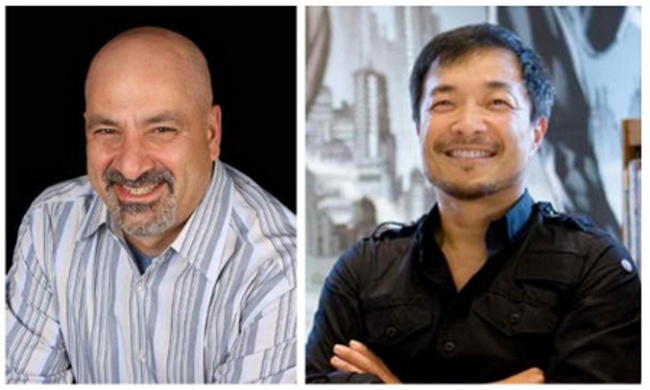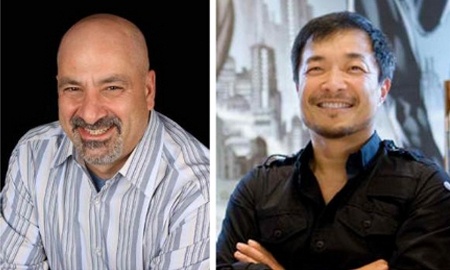We talked about the philosophy behind Rebirth last fall (see "ICv2 Interview: DC’s Dan Dido and Jim Lee"). One of the quotes from that was you were going to "return to continuity-driven, action-adventure stories featuring the classic look and feel of the superheroes." You also talked about getting back the customers who liked DC superhero comics. What does that mean demographically? Does that mean that you’re focusing this DCU periodical relaunch on adult males, which is sort of the old comic audience?
Didio: What we’re trying to do is to build on the audience we created with the "New 52" and hopefully draw back some of the fans and customers that might have felt disenfranchised from "New 52" because there were elements that they enjoyed that they felt were missing from the DC Universe, or from the storytelling. Our goal right now is to be all-inclusive, not to really focus on one particular group but still be able to cut a wide berth for as many people to enjoy our product as possible.
And what was that thing that was missing?
Didio: It was a sense of legacy, the generational aspect of the DC universe. There might have been one or two characters that people felt kinship to that might have been lacking from our storytelling. We went back and looked through to see what characters we think would be most impactful that we haven’t reintroduced to the "New 52." At the same time, we wanted to get back to the core conceits. We were making some wholesale changes and got away from the core of the characters. Ultimately this is getting back to their center again so they’re much more recognizable. If somebody who was a casual fan or a lapsed fan, they might see an element in the art or in the storytelling that feels very comfortable and familiar, something they can relate to and then hopefully come back and enjoy the comics.
So closer to the older versions, in other words?
Didio: It’s not as much closer to the older versions, it’s closer to the core conceits of what these characters are: who they are, what makes them great, what are the elements that people most recognize in them. If you look at the films or the TV shows, you see certain attributes of our characters that are basically taken directly from the comic because that’s what people recognize the most about those characters. We want to make sure all of those attributes are put back in the characters themselves. Some needed more wholesale fixing; some of them needed just slight adjustments.
Lee: I think if you look at what Goeff Johns (who’s been one of the chief creative architects for what we’re doing with "Rebirth") did previously with Green Lantern: Rebirth and Flash: Rebirth, he did two very different things. On Green Lantern, he restored Hal Jordan to be the prime Green Lantern and restored the Green Lantern Corps, and all the things that made that book, that concept unique, that had at times been destroyed or thrown away or changed over the years. The character essentially became a mass murderer, Spectre-type character. So that return was something that re-energized the character and built upon its core foundation.
Then you look at what he did with The Flash, where he introduced the idea that his mother was killed. That was all new, but it added really core, important backstory to the character that made it more meaningful, and again underscored what made The Flash unique. The fact that he was trying to solve his mother’s death, that’s why he became a criminal investigator. There was something that was missing from his past that he added in there to make it a stronger concept.
Part of what will make "Rebirth" unique and different from "New 52" and things we’ve done previously, is that Goeff has really stepped in, as Chief Creative Officer, working with the individual writers. He sat down with writers and editors for hours as a time, days at a stretch, to talk about the core DNA of the characters, what makes them unique and special, and really trying to build concepts and storylines based on what makes those characters interesting.
If you look at a book like Red Hood and the Outlaws, there’s Red Hood, Bizarro and Artemis, and why would they ever team up? If you realize, at the core, they’re the perennial also-rans of the DC universe. Jason Todd was the Robin that failed, Artemis was the amazon that was cast out and exiles, Bizarro was really the mirror image of Superman that was bad and unheroic, so it’s an interesting premise bringing those three also-rans together to form the core of a team. And that’s how you make that book unique and special and different from Justice League and every other team-up book that we have.
So that’s the kind of thing that went into each and every title. A really creative and interesting approach, and what you would think would be your north star every day, but a lot of times creative teams kind of lose sight of creative directions. It’s a way of collectively steering the ship in the right direction.
Another thing we talked about in October was that one of the things you’d learned was that the new buyers entering the market were more likely to be trade-waiters than your core audience. How are you incorporating that knowledge into the "Rebirth" launch? Are you going to do more OGNs for some of the things that appeal to non-core audiences?
Didio: We have some discussions taking place right now and will be talking about it probably this summer. Right now the focus is on "Rebirth" and more about how we want to strengthen the periodical line. That’s one of the logics behind the "double shift." What the double shift allows us to do is deliver product a little more frequently; more in line with how people consume them. We’ve had a lot of success with a weekly series and by doubling down on our better selling titles, our more recognizable characters, we’re hoping to build a much stronger base for our fans and for our periodical line.
You’re going to $2.99 for the books in the "Rebirth" launch. Do you have research that shows trial increases as the price goes down?
Didio: You see research that says there’s pricing sensitivity on the product that has the highest rate of demand, and that there’s also a pricing sensitivity for the lesser products, but that also means that their sales drop much more precipitously. We’re seeing a much greater divide between the top and the bottom of our line. We find that the company’s most healthy when we have we have a strong middle. What we’re hoping here is by giving the double shift at a more affordable price that isn’t something to set people off, that they might be more willing to try the books, sample the books and stay with them on a more consistent basis.
Our goal is to sell more books. We could raise prices and sell less copies and be just as profitable, but I think shrinking our market, shrinking our business any more than it has would be detrimental to us all. We shouldn’t be in a situation where we pat ourselves on the back for minimal sales at high prices. We should be trying to be expanding our business as much as possible, especially given the time that we’re in right now where our characters and product has never been more recognized in film, television and other media as well. We should be growing as awareness of our characters are growing and not shrinking. It doesn’t make sense.
What did you hear from retailers on your recent road trip? Were they nervous about losing 25% of the retail value of the books they’re selling? Do they think the increase in sales will make up for it?
Lee: We were going across the entire country and you’re hitting all different types of stores. There were a few retailers who said, ‘you’re leaving money on the table,’ but overall, most were supportive of the $2.99 line. They knew that that would get greater fan interest in buying into the entire line. In certain parts of the country, a dollar doesn’t go as far as in other parts of the country. You would see different attitudes depending on what part of the country you traveled in.
In general, what was interesting about the whole road show was that we started off on one coast and went across twice over a period of three weeks. The information about what we were doing with "Rebirth" increased during the time we were travelling. We put out the Diamond Previews catalog that was just DC-centric, we had more information going to retailers, we started announcing creative teams, covers, that kind of thing. You saw the retailers slowly understand what we were doing and start to embrace it so that by the end when we were in New York City, which was the days of the FOCs for the first issues, they seemed pretty excited by what we had planned and liked the fact that we took a lot of the learning that we had from the "New 52" and applied it to what we were doing with "Rebirth."
Are the number of pages in the Rebirth books changing from where they were with the higher cover price?
Lee: It’s 20. There’s only one title, All-Star Batman, that’s a higher price point at $4.99, but that’s more pages. It’s in the DK3 format, so thicker card stock cover with gloss.
Is that 20 pages the same as it’s been?
Didio: Yes. It’s exactly what it’s been.
Click here to go to Part 2.




